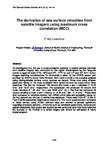The derivation of sea surface velocities from satellite imagery using maximum cross correlation (MCC)
| dc.contributor.author | Lawrence, P. | |
| dc.date.accessioned | 2019-05-20T09:30:01Z | |
| dc.date.available | 2019-05-20T09:30:01Z | |
| dc.date.issued | 2016 | |
| dc.identifier.citation |
Lawrence, P. (2016) 'The derivation of sea surface velocities from satellite imagery using maximum cross correlation (MCC)', The Plymouth Student Scientist, 9(1), p. 145-161. | en_US |
| dc.identifier.issn | 1754-2383 | |
| dc.identifier.uri | http://hdl.handle.net/10026.1/14119 | |
| dc.description.abstract |
An investigation into the use of cross-correlation statistics to resolve surface velocities from satellite imagery was conducted for the region characterised by the Benguela current at approximately 24oS - 28oS and 9oE - 17oE for July 14th and 15th 2011. Colour images depicting concentrations for chlorophyll_a taken by the MODIS sensor and provided by NASA’s Ocean Color Browser, were used to conduct the statistical analysis using distinguishable surface colour features as tracers. Three runs using different parameter values for the cross correlation were carried out and the output vector fields examined. The first run produced 126 vectors with mean u and v velocities of 10.55 cms-1 and 13.37 cms-1 respectively. The subsequent run produced 70 vectors with mean velocities of 1.82 cms-1 for u and 15.97 cms-1 for v. The final run computed 29 vectors showing a mean u and v velocity of 18.75 cms-1 and 12.12 cms-1. These were then compared to velocities derived from ARGO drifter data and probability values for the first, second and third set of distributions calculated. These were 7.03x10-7, 5.26x10-4 and 0.0028 respectively (significance level=0.01). The vector positions were compared to those derived using AVISO altimetry data and showed a general agreement regarding circulatory patterns. Limitations such as correlation parameters, temporal and spatial resolutions, data quality and quantity as well as human error may have restricted the success of the method to a certain degree and should be addressed in future implementation. | en_US |
| dc.language.iso | en | en_US |
| dc.publisher | University of Plymouth | |
| dc.rights | Attribution 3.0 United States | * |
| dc.rights.uri | http://creativecommons.org/licenses/by/3.0/us/ | * |
| dc.subject | sea surface velocities | en_US |
| dc.subject | marine environment | en_US |
| dc.subject | satellite imagery | en_US |
| dc.subject | maximum cross correlation | en_US |
| dc.subject | MCC | en_US |
| dc.subject | tracers | en_US |
| dc.subject | circulatory patterns | en_US |
| dc.title | The derivation of sea surface velocities from satellite imagery using maximum cross correlation (MCC) | en_US |
| dc.type | Article | |
| plymouth.issue | 1 | |
| plymouth.volume | 9 | |
| plymouth.journal | The Plymouth Student Scientist |



